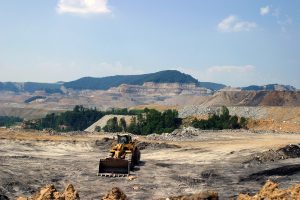Exposed: Mountaintop Removal Coal Mining
Nearly 650 mountaintop removal coal mining sites scar the landscape of central Appalachia. Neighboring communities experience greater levels of air and water pollution and suffer from higher rates of illness than similar communities located further away, says Dr. Michael Hendryx, a professor of applied health science at Indiana University who has contributed to more than 30 studies on the subject.

The destruction of mountaintop removal coal mining at a Roaring Fork Headwaters site in Wise County, Va. Photo by Matt Wasson, Appalachian Voices
Toxic heavy metals present in coal, such as arsenic, mercury and lead, are found in every stage of mining waste. As heavy machinery and explosives remove forests — gouging deep into the land in order to access underlying coal seams — a mixture of rock dust and chemical residue left from the explosives fills the air. A recent air quality study near mountaintop removal mining sites, co-authored by Hendryx, found that even in a controlled lab environment, this dust “can cause cancerous changes to human lung tissue,” a finding that had previously been suggested by health data in nearby impacted communities.
Once removed, rock and soil “overburden” is dumped into nearby valleys, and has buried more than 2,000 miles of Appalachian streams. The water that trickles through the base of these “valley fills” is laden with heavy metals, dissolved salts and other toxic substances, contaminating ground and surface water.
To discuss these issues, join our upcoming webinar discussion with a panel of experts this February.
Visit appvoices.org/webinars.
Streams polluted by mining waste correspond to increased rates of cancer mortality nearby, even after accounting for factors such as smoking and poverty, according to a 2010 study co-authored by Hendryx and Than Hitt, a biologist for the U.S. Geological Survey.
Damage persists even after mining ends. The unearthed coal is transported to nearby processing facilities, separated from soil and rock, then crushed into smaller chunks. This creates tons of additional dust, which includes particulate matter, sulfur dioxide and nitrous oxides that contribute to acid rain and respiratory illnesses as well as cancer. Afterwards, the coal is washed using chemicals known to cause cancer and heart and lung damage.
After washing the coal, the leftover waste — called slurry— is disposed of either in open-air, unlined ponds, or injected underground. A multitude of studies have found that the same contaminants present in mining runoff and slurry turn up in drinking water.
More Stories

Leave a comment
Your email address will not be published. Required fields are marked *





Leave a Comment